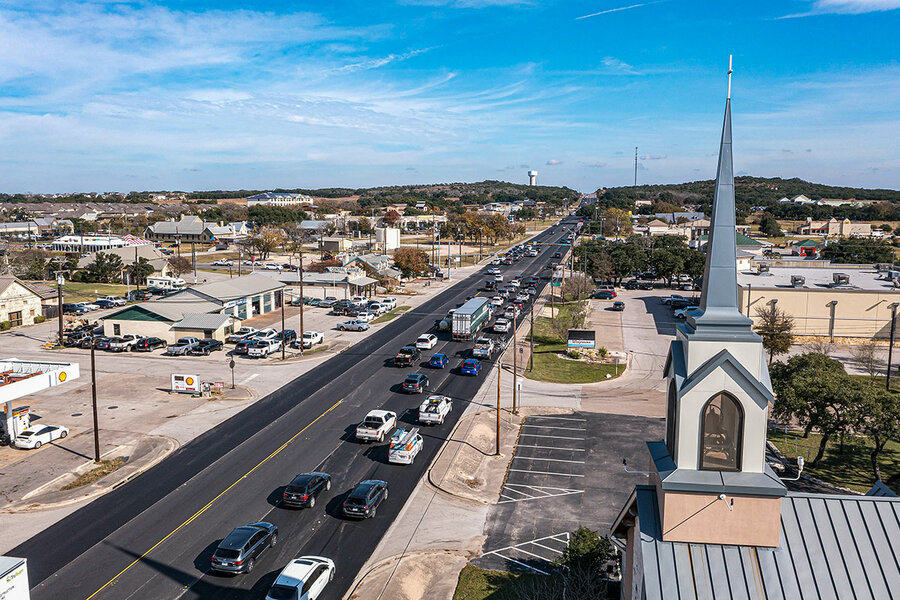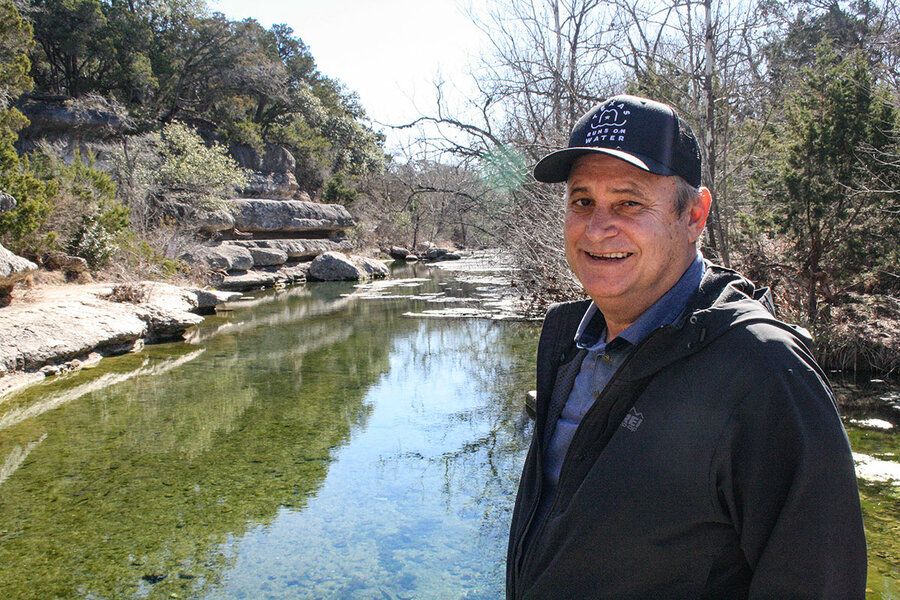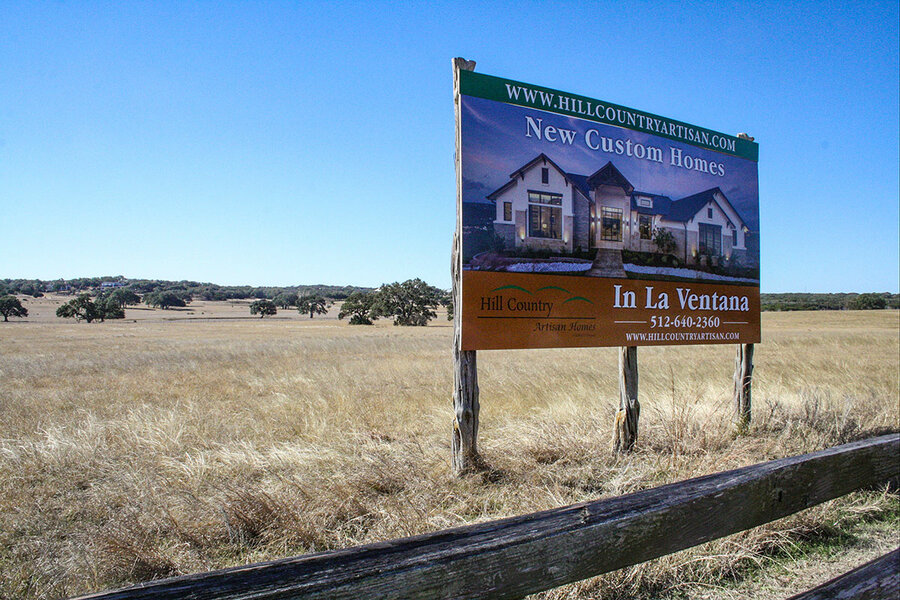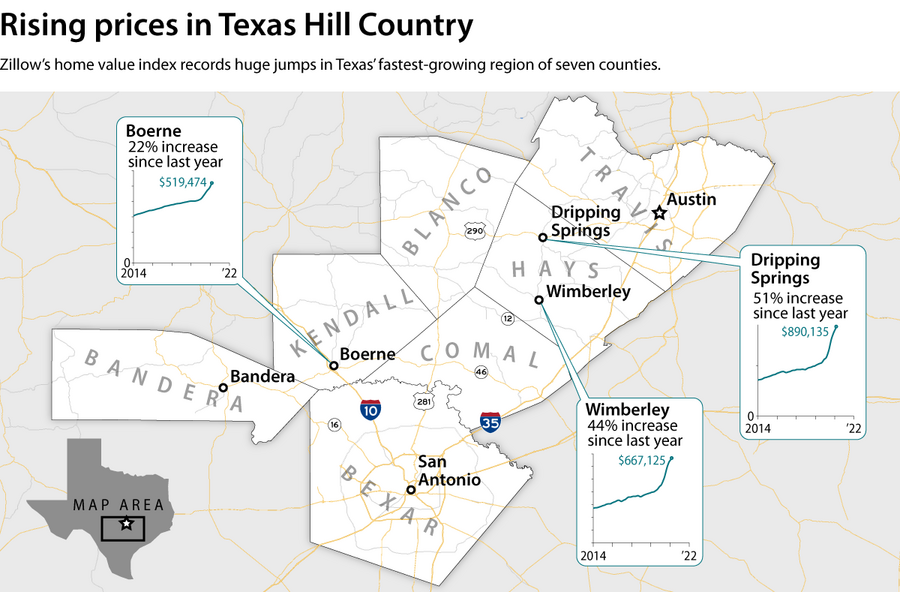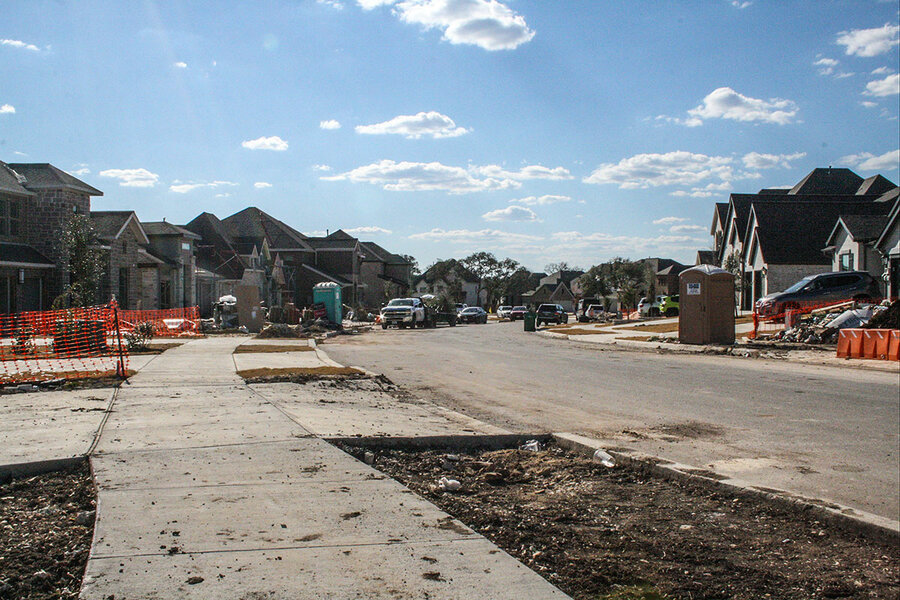Is Texas Hill Country in danger of being ‘loved to death’?
Loading...
| Dripping Springs, Texas
In rapidly growing Texas, a rustic area west of Austin and San Antonio leads the way in the pace of population gains. Development is inevitable, but not inherently bad, locals here in the Hill Country say.
It needs careful management, they add, but that isn’t something Texas has typically prioritized. The clock is ticking to safeguard what has made the Hill Country so attractive to newcomers.
Why We Wrote This
The Hill Country of Texas is the fastest-growing area of this fast-growing state. But questions about how to manage that growth, from water supply to school commutes, are rising.
Locals worry about traffic, affordability, and the loss of small-town character. Eighteen-wheelers roll over narrow country roads, and new housing developments dot the limestone hills. Home values are climbing as low-wage workers struggle for housing.
And of all the development-related issues here, water might be the most challenging. Sewage systems are hitting capacity, and drinking water supplies may not last through the next drought. More people in the Hill Country means not just more demand for drinking water but also more sewage and more pavement – putting fragile aquifers at risk of contamination.
“Everybody is, you know, loving it to death almost,” says David Baker, executive director of the Wimberley Valley Watershed Association. “That’s the challenge: how to balance growth with conservation.”
Deep in the heart of Texas, the traffic is backed up for almost a mile.
It’s a jarring sight for long-time residents of the Hill Country, a rural oasis of scrubby green hills, crystalline water, and bright white limestone west of Austin and San Antonio. But it’s not the only sign that change is afoot in this once rustic and hardscrabble region of the Lone Star State.
Eighteen-wheelers roll over the narrow country roads, and housing developments dot the limestone hills. Home values are climbing as low-wage workers struggle for housing. Meanwhile, sewage systems are hitting capacity, and drinking water supplies may not last through the next long drought.
Why We Wrote This
The Hill Country of Texas is the fastest-growing area of this fast-growing state. But questions about how to manage that growth, from water supply to school commutes, are rising.
In one of the fastest growing states in the country, this is the fastest growing region. The population has grown by nearly 50% in the past two decades, according to the Texas Hill Country Conservation Network (THCCN), with much of those gains in unincorporated – and largely unregulated – areas.
There have been positives. A larger tax base is funding high-quality schools; small businesses, particularly in tourism and hospitality, are flourishing. Development is inevitable, and not inherently bad, locals say, it just needs to be planned carefully.
But careful, regulated growth isn’t something Texas has typically prioritized. And with growth and development here only expected to continue in coming decades, the clock is ticking to lock in safeguards for what has made the Hill Country so attractive to newcomers.
“Everybody is, you know, loving it to death almost,” says David Baker, executive director of the Wimberley Valley Watershed Association.
“That’s the challenge: how to balance growth with conservation,” he adds. “How do we make sure that we don’t destroy the thing that attracted us here in the first place?”
Rapid growth – especially beyond the city limits
There was a time when Dripping Springs – known as “the Gateway to the Hill Country” – didn’t have a single traffic light. Today it has five, and a bona fide rush hour.
The sign at the city limits informs visitors of the population just shy of 1,800, but the sign has been out of date for over a decade. The population has more than doubled since then, and 10 times that number live outside the city limits in its so-called “extraterritorial jurisdiction” or ETJ.
“In the last five years the traffic has been out of control,” says Bill Foulds, the Dripping Springs mayor.
Like most Hill Country towns, recent population growth has not been in Dripping Springs itself, but in its ETJ and unincorporated areas of the county. Residents there don’t pay city taxes, but many do use city roads, sewer systems, and other infrastructure.
Dripping Springs’ population still isn’t big enough to justify a police or fire department. Mayor Foulds desperately wants to improve the city’s central intersection, but there’s only so much they can afford.
In the counties directly west of Austin and San Antonio, the population in unincorporated areas has more than doubled in the past 30 years, according to a recent report from THCCN, a coalition focused on preserving the region’s culture and natural resources. In addition to city infrastructure, those residents also benefit from access to local schools.
“We take it to heart that we cause some of the traffic problems here,” says Thomas Price, superintendent of the Boerne Independent School District.
Indeed, weekday mornings and midafternoons in the city herald a choke of cars dropping off and picking up students. Over 10,000 children attend the district’s 12 schools, and 400 have joined this year alone.
Enrollment is expected to double in the next 10 years, and the district wants to get ahead of the inevitable traffic challenge.
One example: They’re hoping to put an elementary school in a new subdivision, near two other subdivisions, so more kids are walking, biking, or riding buses.
Dr. Price grew up in Houston, watching the city sprawl out 30 miles in every direction with little forethought. He doesn’t want Boerne to end up in that situation, he says, “trying to figure it out afterwards.”
A “miracle,” but is it affordable?
If “the Texas Miracle” could be captured in one image, it might be the main street of a town like Dripping Springs or Boerne.
While cars pack the streets, people crowd the sidewalks. Antique shops, boutique clothing stores, and small restaurants stand next to chain stores like Walgreens, Home Depot, and H-E-B grocery stores.
A combination of low taxes and business-friendly policies have fueled this “miracle” of growth and prosperity, state leaders say, and helped Texas weather the Great Recession and the pandemic better than most states, economically. (When it comes to the COVID-19 death rate, Texas ranks roughly in the middle.)
The degree to which that is true – and not just the result of, for example, a thriving oil industry – has been debated for years. But in the Hill Country, while the economic benefits of growth have been welcomed, some market forces have been raising concerns.
The Hill Country region saw an unprecedented volume of land sales, and increases in land prices, beginning in the second half of 2020, reported the Texas Real Estate Center at Texas A&M University. And as land values have surged, so have home prices and rent.
In Boerne, Ty Wolosin has seen it firsthand. Both a city council member and owner of a brewpub in the heart of the town’s Main Street, he has staff making $17 an hour. “It’s still hard [for them] to afford to live in Boerne,” he says.
Meanwhile, the school district is struggling to hire hourly-wage workers like custodians and bus drivers, most of whom have to commute from more affordable San Antonio suburbs. At one of the high schools, just five of 14 custodial positions are filled, says Dr. Price.
“There’s not a lot of affordable housing,” he adds. “If we want to be a viable community ... that’s got to be a focus.”
Growth itself could be an answer to affordability issues, some argue.
“It will attract more services and things that will keep our economy diversified and attract opportunity for everyone,” says Jason Giulietti, president of the Greater San Marcos Partnership, a nonprofit that works with a variety of stakeholders – from business leaders to environmental groups – in Hays and Caldwell counties to attract suitable businesses to the region.
“Growth is going to happen,” he says. “We think by being involved and active in it, it lets you control that narrative a bit more.”
Keeping local character alive
In a region where locals used to drive to Austin or San Antonio to buy groceries, development has brought more convenience, but also more homogeneity.
“We’re seeing a sort of encroachment on local community character, local economies,” says Cliff Kaplan, program director at the Hill Country Alliance. “Most towns would like to see that look and feel maintained throughout their new development.”
Bandera has been particularly focused on this. Thirty minutes west of Boerne, the town known as “the Cowboy Capital of the World” has not yet seen the growth of some Hill Country cities.
There isn’t an H-E-B, and the largest store is the Tractor Supply Co. on the edge of town. Downtown, one- or two-story shops line the street with awnings covering the narrow sidewalks. Hitching rails for horses are still found, and used, outside businesses. As a whole, the town’s layout is virtually unchanged from the 1800s.
Rebeca Gibson, a city council member, is hoping it will stay that way regardless of the development she knows will arrive in the coming decades.
An effort by the city council to revamp local zoning codes is “very, very technical,” says Ms. Gibson. But “it’s a great example of how our city is working towards achieving more responsible development.”
A fragile water supply, under strain
Bandera is now hoping to get ahead of the next big challenge: water.
The town can look like a sepia-toned photograph of the old West, but there’s nothing nostalgic about the liquid waste known as effluent – from the local wastewater treatment plant and sometimes from surface runoff – draining daily into the Medina River that flows through town.
A new wastewater treatment plant is in the works (further from the river), along with some other potential disposal methods.
“I’m just grateful that we have the opportunity to change it,” says Ms. Gibson.
Indeed, of all the development-related issues here, water might be the most challenging – and one where many cities, unlike Bandera, are playing catch-up.
First, there isn’t much of it. The primary source of drinking water has long been a network of underground aquifers flowing through the karst limestone under the hills and feeding a thousand miles of pristine streams. And these aquifers are among the most stressed in the state.
Second, the water that is there is exceptionally clean, and exceptionally easy to contaminate. Karst is the geological equivalent of Swiss cheese, full of holes that allow rainwater – and contaminants – to easily infiltrate the water supply. A diverse and fragile ecosystem has developed around this pristine but fragile hydrology, and development poses a variety of threats.
Developing open land could pave over areas where water can filter down into the aquifer, and it could whisk contaminant-laden effluent directly into streams and rivers. More people in the Hill Country means not just more pavement, but also more sewage and more demand for drinking water.
“Governmental entities charged with stewarding our water resources are faced with an almost impossible task,” says Mr. Kaplan from the Hill Country Alliance.
In Dripping Springs, the wastewater system has hit its maximum capacity. The city has implemented a moratorium on development, and for six years it has been trying to get a new wastewater discharge permit from the state to increase capacity. The permit has been tied up in legal battles, however, as environmental groups fear the permit would lead to the pollution of local waterways.
David Baker’s dilemma
When it comes to water in Boerne, quantity is as big a concern as quality for Micah Voulgaris. As general manager of the Cow Creek Groundwater Conservation District, the local groundwater regulator, it’s a looming crisis he can’t ignore.
“The drought of record is the seven-year drought in the 1950s,” he says, settling into a leather chair in a meeting room at his office. “It’s not an ‘if,’ it’s a ‘when’ on a drought worse than in the ’50s.”
Meanwhile, the interstate through Boerne is slated for expansion, and the city continues to grow. The district hasn’t been drilling as many wells as they did when he started there in the early 2000s. Instead they’ve been restricting the number of wells landowners can have. But it all adds up.
“You’re constantly adding onto that total use,” he says. “Water levels are going to decline the more people you have using it.”
Leaning back in the chair, he sounds tired. But he tries to strike a more positive note.
“People aren’t going to just stop moving here,” he says. “We just have to figure out: Is what we’re doing going to be enough along the way?”
David Baker was on his way to New Mexico in 1988 when he stopped in Wimberley for the first time. He saw Jacob’s Well, a natural spring that sinks over 100 feet into the Hill Country aquifer system, and never left. The spring shares a name with his son – 9 months old when they found it – and it was privately owned then, so he bought a portion and opened a bed and breakfast named Dancing Waters. His daughter was born at the B&B.
In 2000, for the first time in its history, the spring stopped flowing, and it’s stopped flowing twice more since then. Mr. Baker donated a conservation easement on his land and sold the well to WVWA, with the county eventually acquiring the property. He's devoted the past quarter-century of his life to preserving Jacob’s Well and other Hill Country natural resources. He’s now such a conservation icon here that a species of amphipod discovered in the spring last year is named after him (Stygobromus bakeri).
He’s been telling his story for decades, and it’s one he repeats to two elderly women he runs into on their way to the well on a warm morning last month.
The women aren’t just visitors. One of them – from Denton, a city north of Dallas – tells him she’s looking to move here. It feels great to get out of the city, she says. She’s just hoping land prices here fall back into her budget.
Mr. Baker thanks them and wishes them a good visit.
“Sometimes I’m like, ‘Oh man, it’d be nice to just not have all these people here,’” he says. But it’s a dilemma.
The more people who visit Jacob’s Well – and the Hill Country – the more people will, like him, want to move there. But the more people who visit, the more people will, like him, want to protect places like the well.
That’s the hope, at least.
“Deep down inside, we all know we need water to survive,” he says.
“It’s a miracle that millions of gallons of water is coming out of the ground that we can still drink,” he adds. “It’s up to us to notice that and appreciate it.”
Editor’s note: This story has been updated to clarify both steps David Baker has taken with his Jacob’s Well property and the timeline of his efforts.




